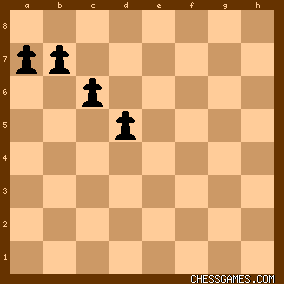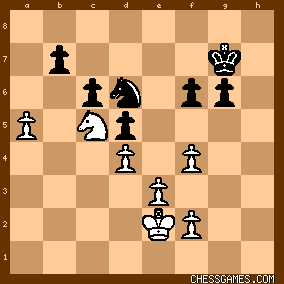|
< Earlier Kibitzing · PAGE 2 OF 2 ·
Later Kibitzing> |
Apr-20-16
 | | offramp: I've never seen a knight on b6 (QN3) that looked happy. I think it's the worst square for a knight. Even h1 seems better. |
|
| Apr-20-16 | | Appaz: <<offramp> I've never seen a knight on b6> Here it eyes for c4 however and it would be crazy for white to trade of his WSB for it as he would be completely toast on the white squares. White will castle long, so this knight has a future imho. |
|
| Apr-20-16 | | Knight13: <I've never seen a knight on b6 (QN3) that looked happy. I think it's the worst square for a knight. Even h1 seems better.> Any Alekhine Defense players here who want to comment on this? |
|
| Apr-20-16 | | Absentee: <Knight13: <I've never seen a knight on b6 (QN3) that looked happy. I think it's the worst square for a knight. Even h1 seems better.> Any Alekhine Defense players here who want to comment on this?> I'll pass. |
|
Apr-20-16
 | | tamar: The knight steps out of the way to let the bishops flash around for awhile, then when White is distracted, it sneaks back to c8 and d6? |
|
| Apr-20-16 | | kellmano: <offramp: <Knight13: <offramp: ... In fact most players seem to have two or three or more peaks before the final levelling off and death.> It'd be cool if you can provide a source for this.>
There's no source I'm afraid>
It rings true I think |
|
Apr-20-16
 | | chancho: If Carlsen has been at his peak for the last six years, (as alleged) then his peak began when he was 19?! Giri is 21, So is 22.
Are they in their peak right now?
I don't believe so.
(no pun intended)
Carlsen turns 26 in November.
He has not reached his peak either imo.
Kasparov was at his strongest in playing strength when he was about 34. Who's to say that Carlsen cannot be as strong when he turns 34? |
|
| Apr-20-16 | | beenthere240: Is anyone especially impressed by Carlsen's conduct of this game??? |
|
| Apr-20-16 | | beenthere240: I think MC will manage to draw this incredibly complicated position. |
|
Apr-20-16
 | | benveniste: I see this position as dead equal. But Carlsen has a time advantage and has been consistently outplaying opponents in this sort of position. I think he's still got solid winning chances. |
|
| Apr-20-16 | | beenthere240: You may be right. If anyone has a taste for long maneuvering in even positions, it's our boy. In fact, he's probably now getting interested in the game for the first time. |
|
Apr-20-16
 | | tpstar: Black's Queenside Pawn structure is called the Carlsbad Formation:
click for larger viewIt is strong for Black as the Pd5 is firmly protected, yet White often tries a Minority Attack advancing the a & b Pawns to induce weaknesses and hopefully win material. This plan is unlikely now during the endgame, but note White has a nice outpost for the Knight at c5. RRN vs RRN is very tricky, almost as bad as QRN vs QRN. |
|
| Apr-20-16 | | agb2002: <tpstar: ...
RRN vs RRN is very tricky>
A possibility is (white to move)

click for larger view |
|
Apr-20-16
 | | tamar: 25...Rh5 might be the only move to keep the tension. |
|
Apr-20-16
 | | tamar: Mutually assured boredom nudges players into repetition. |
|
| Apr-20-16 | | luftforlife: <tpstar>: Thanks for your concisely instructive mention of the Carlsbad pawn structure. Although, as you mentioned, a minority attack by White in this game now seems unlikely, I found the following article by WGM Raluca Sgîrcea and IM Renier Castellanos helpfully amplified and supported your point: http://www.thechessworld.com/learn-.... Thanks again. |
|
Apr-20-16
 | | tpstar: <luftforlife> Great article with great reference games! I like how the three games feature the middlegame and endgame play directly resulting from the opening choice. If Black is forced to advance ... a6, that creates dark square weaknesses on the Queenside, while if Black is forced to advance ... b6, that weakens the Pc6. |
|
| Apr-20-16 | | luftforlife: <tpstar>: Glad you found the article worthwhile! Yes, the textual overviews and tactical breakdown dovetail nicely with the three examples chosen by the authors of successful minority attack by White agsinst Black's Carlsbad pawn-formation. More specifically, Petrosian vs H Rossetto, 1958 1-0 reveals by direct onslaught the fatal implications of Black's weakened c-pawn; Smyslov vs Keres, 1948 1-0 features the successful structural exploitation of both Black's weakened a-pawn and c-pawn; and Karpov vs Ljubojevic, 1989 1-0 displays by withering fire the devastating capitalization upon Black's weakened a-pawn. I take your points above regarding . . . a6 and . . . b6, which further my understanding beyond the content of the article. Thanks again for sharing your knowledge and expertise. Kind regards. |
|
Apr-20-16
 | | Ron: I won some chess bucks. |
|
Apr-20-16
 | | perfidious: One classic game not cited in the <chessworld> article is Larry Evans vs H Opsahl, 1950. |
|
| Apr-20-16 | | frogbert: Heh. I played Opsahl about 45 years later. :) |
|
Apr-20-16
 | | tpstar: <luftforlife> Game Collection: 51d_Middlegames - queenside Minority Attack |
|
| Apr-21-16 | | Ulhumbrus: If 12..Bg4 prevents 13 h5, this suggests 12 h5. However then 12...Bg4 forks the h5 pawn and N on f3. This suggests 12 Ne5. Instead of 15 Ke2 15 Qxe2 keeps the options of 0-0-0 and h5 |
|
| Apr-21-16 | | luftforlife: <tpstar>: Thanks very much! |
|
| Apr-23-16 | | thegoodanarchist: <offramp: I've never seen a knight on b6 (QN3) that looked happy. I think it's the worst square for a knight. Even h1 seems better.> Check out White's position after mover 39 in this game: B Eley vs Uhlmann, 1972 |
|
 |
|
< Earlier Kibitzing · PAGE 2 OF 2 ·
Later Kibitzing> |





